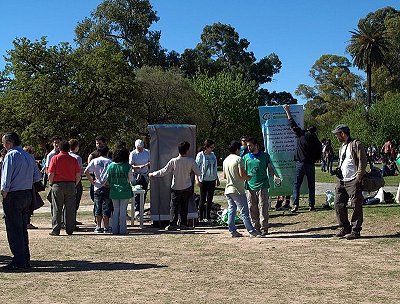Page 4 of 6
Buenos Aires, Argentina
 The AVAAZ appeal amplified by local NGOs and civic organisations, including Mundus maris, was heard and acted upon also in Buenos Aires, the capital of Argentina.
The AVAAZ appeal amplified by local NGOs and civic organisations, including Mundus maris, was heard and acted upon also in Buenos Aires, the capital of Argentina.
Argentina is a huge country with varying climatic and weather conditions in different parts.
But like glaciers in other parts of the world, Argentinian glaciers in Los Glaciares National Park, Patagonia, are melting.
The country certainly has a good potential for creating "green jobs", but - as everywhere - rethinking "conventional" approaches to agriculture and mobility is a big effort. From there to actually doing it, it takes a lot more pioneering efforts.
 Climate change impacts in Argentina - this is what the International Panel on Climate Change (IPCC) 4th Assessment Report has summarised:
Climate change impacts in Argentina - this is what the International Panel on Climate Change (IPCC) 4th Assessment Report has summarised:- Highly unusual extreme weather events were reported, such as flooding in the Argentine Pampas (2000-2002) and hail storm in the Great Buenos Aires area (2006) [TS4.2].
- Increases in rainfall in southeast the Argentine Pampas have had impacts on land use, crop yields and have increased flood frequency and intensity [TS4.2].
- Declining trend in precipitation has been observed in southwest Argentina [TS4.2].
- In the future, sea level rise, weather and climatic variability and extremes modified by global warming are very likely to have impacts on low-lying areas (e.g. province of Buenos Aires coast) [13.4.4].
- In recent decades, a trend to wetter conditions in parts of southern South America has increased the area inundated by floods, but also has improved crop yields in the Pampas Region of Argentina, and has provided new commercial fishing opportunities [3.5].
An invitation to pull up the sleeves and develop alternatives.
Photos by Marcelo Lino Morales Yokobori.








